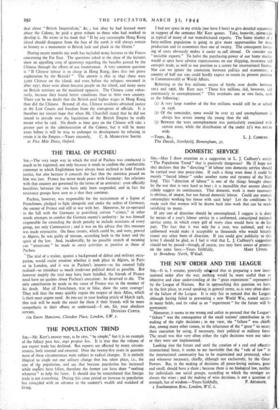THE POPULATION TREND
Sta,—Mr. Kerr's answer may, as he says, "be simple," but it .is an example of the fallacy post hoc, ergo pro pter hoc. It is true that the volume of our export trade has declined. But exports are affected by many circum- stances, both internal and external. Over the twenty-five years in question most of these circumstances were subject to radical changes. It is entirely illogical to single out one solitary change that has taken place, i.e., the size of the population, and say that because population has 'increased while exacts have fallen, therefore the former can have done "nothing whatever" to help the latter. It should also be remembered that foreign trade is not everything. During this same period an increase in population has coinsided with an advance in the country's wealth and standard of living. I had not space in my article (nor have I here) to give detailed argument, in Support of the sentence Mi. Kerr -quotes. . Take, howeve'r- niotor-cais as typlcal'of 'many of our matnifactured exports. The -home niarket of 3 forty-million population is going to give more opportunities for mass production and its economies than one of twenty. The consequent lower- ing of costs obviously makes it easier to sell abroad. Or consider our "invisible exports." To -halve the purchasing-power of our home marker would at once have adverse repercussions on our shipping, insurance and entrepet trade, as well as our position as a centre for international finance. Nor can we ignore the connexion between politics and economics; 3 country of half our size could hardly expect to retain its present position in Commonwealth or World Affairs.
Referring to the five millions excess of births over deaths between 1913 and 1938, Mr. Kerr says "These five millions did, however, add enormously to unemployment." This overlooks one or two facts, such as the following: (i) A very large number of the five millions would still be. at school in 1938.
(2) Of the remainder, none would be over 25 and unemployment is always less severe among the young than the old.
(3) Between the wars unemployment was particularly assOciated with certain areas, while the distribution of the under 25's Was natbn wide.
The Davids, Northfielit Birmingham, 31.






















 Previous page
Previous page